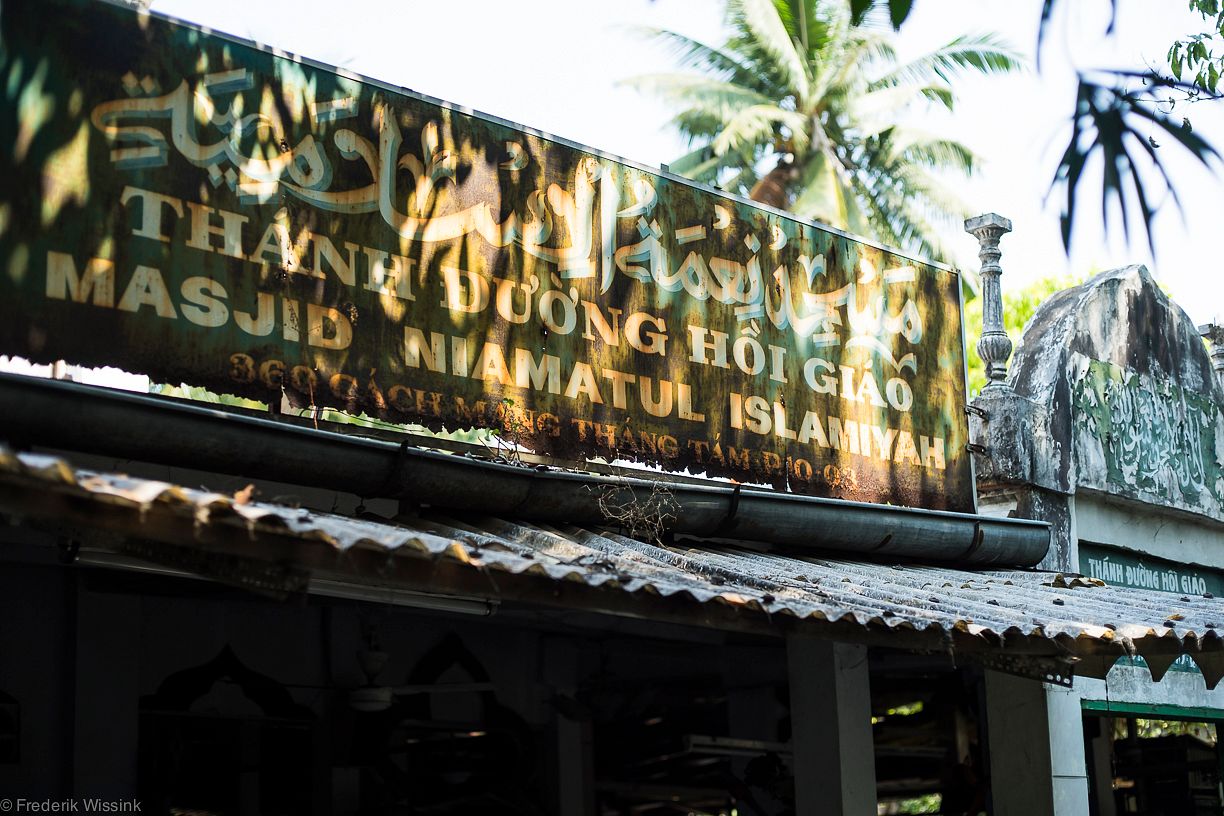The gate to Masjid Niamatul Islamiyah does its best to hide the shaded, green garden behind it from street view. On the outside, you’re more likely to notice the motorbike repair shop next door spilling out onto the sidewalk than the high, faded gray-green metal gate in the background. Peek over the fence and the courtyard doesn’t seem like anything special, either, until you begin to notice the pastel-hued headstones floating between plants at the back of the complex and the green-and-white lettering above its modest prayer hall on the left.

Since its construction in 1952, Hakeem Haji Musa Hamit and his family have been taking care of District 10’s modest Niamatul Islamiyah, a one-room prayer hall dedicated to the area’s Muslim community. Decades ago, Hamit tells Saigoneer, when the city was home to droves of Indian traders and businessmen, Niamatul Islamiyah was built to accommodate not only the Indian migrants who facilitated its construction but also Chinese, Cham and Vietnamese members of the faith.

Now the imam of Niamatul Islamiyah, Hamit carries on the tradition of his Malaysian father, who served as the mosque’s imam before him. A slight, 70-year-old man, he recalls large crowds at the mosque throughout his childhood, gathering for regular prayer as well as religious holidays. Though much of Saigon’s Indian community has since disappeared, today the mosque sees around 70 to 80 people every Friday, he estimates, while Islamic holidays can draw up to 200 people. Niamatul Islamiyah’s demographics, too, have shifted: Hamit says Vietnamese, Indonesian, Indian and even Sudanese Muslims visit the mosque, as well as the occasional Muslim traveler.


Though the world beyond those gates has changed drastically, life inside Niamatul Islamiyah remains, for the most part, frozen in time. Hamit's family lives nearby and handles the cleaning and maintenance of the mosque. An open-air, concrete kitchen stands beside the modest prayer hall, accommodating those who care for and visit the complex, but by and large the land is occupied by gravestones dating as far back as the late 1800s.

Unfortunately, many of the cemetery’s secrets have been lost to time — after 1975, Saigon’s Indian traders returned home, taking with them the histories of Niamatul Islamiyah’s deceased, most of whom are Indian — but a handful of details are still inscribed on the tombstones at the back of the property: a hometown, a profession or a relative’s name.

According to Hamit, this is but the last generation of those buried at Niamatul Islamiyah. Years before, he explains, the deceased were laid to rest without gravestones, their bodies sinking into the earth. As time passed, the mosque reused burial plots, burying the deceased atop one another until the final person was laid to rest in 1984. Today, photos of the gravestones are forbidden and the cemetery is unknown to the outside world; however, occasionally, relatives of the deceased, most of whom live overseas, return to pay their respects.


It is, perhaps, because of Niamatul Islamiyah’s cemetery that you’ll also find a wooden funeral cart on the property. No one uses it anymore – the vehicle has fallen into disrepair since its last run – but the carved wooden horse cart once shepherded the deceased from their homes to the cemetery for burial.

Even though the funeral cart no longer travels Saigon’s streets, little else has changed at Niamatul Islamiyah, and the mosque’s caretakers seem content to maintain the status quo. For Mazigiah, one of the women who takes care of the mosque, religion takes precedence over all other things.

“Worrying about life is 40% of your time, religion is 60%,” she explains. “Religion takes priority.”
For those beyond Niamatul Islamiyah’s gates, however, Saigon’s breakneck pace of development has altered the cityscape around the mosque. In recent years, city officials have looked into repurposing the mosque’s land for other projects. While Niamatul Islamiyah’s residents are not fond of this idea, their main concern is the cemetery: the deceased cannot be disturbed.


Though city officials have vowed to leave Niamatul Islamiyah’s land alone for the time being, the future is a mystery for this tiny corner of District 10. Metro construction will dig up the street outside their gates, while officials are still mulling the idea of building a station exit on part of the mosque property. Whatever happens, the caretakers will hold onto what little they can, preserving an oft-forgotten part of the city's history within its shaded garden and the pastel-colored walls of Niamatul Islamiyah.

Imam Hakeem Haji Musa Hamit with his family and caretakers of the mosque.
Darkroom is a Saigoneer series documenting the beauty and stories of Vietnam and beyond via photographs. If you have a compelling story you wish to share, send us an email via contribute@saigoneer.com.

















